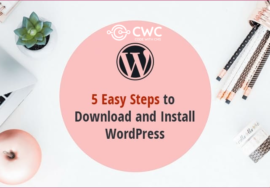
7 Key Elements of Effective Business Websites
Your business website is your home base. It’s where potential customers will land when they Google for what you offer, and it’s the spot that will have the highest chance of converting them into paying customers. But effective websites are hard to come by — and bad ones can actually limit your success.
That’s why in this blog post, we’ve identified a few design and marketing principles that (if applied correctly) can turn your business website into a conversion machine (alongside powerful content of course).
So without further ado, let’s jump right in. Here’s key element number one →
1. Ensure Using a Good CMS and Code
CMS stands for Content Management System – a platform or software you can use to manage and publish your content. I’m sure you’ve heard of WordPress. It is the most popular CMS for web development with a 64% market share in the CMS domain.
Another good example of a CMS is Shopify which is a top choice for ecommerce websites. Other good options include Drupal, Joomla, and Squarespace.
A good CMS is essential, as it ensures your site loads well on all devices. It also helps you avoid bugs, glitches, and usability problems. You also won’t have to worry about coding, as you’ll be able to install plugins and add special features to customize your website.
In addition, if you hire a coder to build your website from scratch, make sure they are well-versed in their industry. Don’t cheap out on this. While creating an HTML website from scratch can allow for more flexibility and customization, it’s also easier for bugs and flaws to creep into the design.
Even if you use a CMS, you need to use the right theme and plugins. There are over 50,000 plugins on WordPress for all types of use cases. However, some are poorly coded and can cause your site to slow down or experience bugs. In addition, some themes are smoother and offer a better user experience than others.
2. Always Use Relevant and High-Quality Content
Quality content will help you rank better in the SERPs and drive free, organic traffic to your blog posts and landing pages. The more competitive your niche is, the more critical content quality becomes. Thin content that only superficially explains a subject won’t help you rank as well as a well-written and comprehensive guide or post.
For content to be considered high-quality, it should:
- Be well-written and easily understandable by all audiences
- Clearly explain the subject and answer the question of the reader
- Be broken down by headers and paragraphs, making it easier to skim
- Include images, videos, GIFs, and other media
- Include your target keywords
As an aside, content with the above qualities is also more likely to get organic backlinks.
Long-form content tends to rank better, so aim for 1,000-2,000 words. At the same time, don’t write more words just for the sake of it. Adding a lot of “fluff” to your content to increase your word count artificially won’t work; Google is pretty good at detecting such content. Instead, discover new issues and questions that people have and talk about them to increase the length of an article.
Of course, your content must be highly relevant as well. Don’t spread yourself too thin by talking about all types of topics that aren’t relevant to your niche. Stick to topics your audience is most interested in.
You can get relevant content ideas by:
- Using suggested keywords from keyword tools such as Ahrefs.
- Using the “People Also Ask” section in the Google search results
- Checking related and suggested searches on Google
- Using Reddit, Quora, and niche forums to see people’s top questions and concerns
- Looking at comments on your blog posts and social media posts
- Asking your readers directly about which issues trouble them the most
3. Come Across as Trustworthy
Increasing trust in the eyes of your customers will help you drive more leads, sales, and referrals. There are a few ways to increase trust on your website. You can add trust signals on your web pages, include testimonials, and focus on delivering good service quality (we’ll come to that in a bit)
However, when it comes to increasing trustworthiness, the general UI/UX design of your website matters the most. According to researchers, it takes just 200 milliseconds for visitors to form an opinion of your brand after landing on your website. You can also embed Google reviews on your website to improve its trustworthiness and to make your website visually appealing.
If your website looks sleek, professional, and well-designed, people will be more likely to trust you. On the contrary, people will be less likely to trust you if your website:
- Is poorly-designed
- Is not mobile optimized
- Has too many ads
- Has too many flashing elements
- Looks like it is from the 1990s
Factors that increase trustworthiness include:
- Inserting testimonials on the front page or sidebar, as mentioned above.
- Adding customer reviews to posts, products, recipes, locations, etc.
- Allowing comments and responding to comments
- Including trust badges, certifications, and verifications on your website
- Installing an SSL certificate
- Adding a contact form that is easy to find
- Adding all of the above to your website shows you are open and honest.
4. Deploy an Easy Navigational Structure
Your website must be easy to navigate if you want visitors to find your top pages, sign up for a trial membership, purchase products, etc. Otherwise, visitors to your site will get overwhelmed quickly, and you’ll lose them before you can convert them.
If your bounce rate is high, poor website navigation may be a factor. The bounce rate is the percentage of visitors to a particular website who navigate away from the site after viewing only one page without visiting any other pages.
So, how can you make your website easier to navigate? Here are some structural design pointers to help:
- Use parent pages to categorize your blog posts and product pages
- Make your menu options simpler to read
- Include fewer menu options or break your menu into two (one in the header and one in the footer, for example)
- Make sure your menu is mobile-optimized
- Add a search bar to your site, so people can easily find topics and products
- Add tags to blog posts and pages
- Avoid excess pop-ups, slide-ins, flashing ads, etc.
5. Choose a Professional Design
As I explained, choosing a professional design will help make your site more trustworthy at first glance. However, it also makes it more likely for people to purchase from you. If your website doesn’t look professional, people will be less likely to follow through on CTAs or give you their credit card information.
That’s why selecting the right theme is critical. WordPress, Shopify, and other content management systems have plenty of free themes. However, I recommend using a premium theme. Premium themes are not very expensive (there are many awesome ones for less than $50-100), and they help you stand out and look more professional.
6. Effective Retention and Conversion
Did you know that a 5% increase in your retention rate can increase your ROI by up to 95%? It costs a lot more to attract new leads and convert them into paying customers than to retain existing ones. Existing customers have proven to be spenders, and they are also familiar with your website and satisfied with your products and quality of service (if you did a good job).
There are a few ways to improve your retention rate. Email marketing is very effective at promoting upsells and down sells after an initial purchase. Ensure you provide value instead of only promoting products to your email list. To show your gratitude to previous purchasers, you can send them special discounts that are not available to newcomers.
A loyalty program can be very effective as well. Loyalty programs work by encouraging customers to continue purchasing to get more bonuses. The more they buy, the more they are motivated to spend so they can reach a particular milestone and qualify for a reward. A perfect example of a qualified reward for ecommerce store owners is to offer WooCommerce rewards to their users. By installing a rewards plugin from the WooCommerce platform, store owners can attract more buyers.
Loyalty programs come in different forms. You can use a points system and allow customers to redeem points for discounts or free products. You can also offer cashback or use a “Buy One, Get One Free” system. If you’re willing to get more sophisticated, you can issue company loyalty cards which users can use to get special discounts.
It’s also critical to increase your conversion rate to keep attracting new customers. Start by including clear CTAs on your website. While you don’t want to be too promotional, you also don’t want to miss out on opportunities to promote products. For example, at the end of a blog post, you can link to one of your sales pages and recommend your product as a way to solve the reader’s problem.
7. Ramp up security with an SSL Certification
Finally, your website must be secure. SSL certificates are essential because users will be looking for the lock icon on their browsers, especially if they have to enter personal information.
You must also develop safety protocols to safeguard any customer information you store. Getting hacked and having your customers’ details leaked can be your worst nightmare. It will ruin any degree of trust you worked so hard to build up, and it will be hard to regain that trust again.
Even if you don’t collect any customer information on your website, you should install a plugin like All In One WP Security & Firewall to protect your website from malware and hackers. After all, you don’t want to subject your users to explicit ads on your website or have them redirected to a gambling site.
Final Thoughts
Looking to build an Effective Business Website? Our team at CodeWithCMS has created effective business websites for thousands of clients worldwide.
Check out our case study of an incredible CPA firm known by the owner’s namesake – Robyn D Jefferson. Like Robyn, we can help you create an effective business website that acts as an ideal conversion funnel.
From building Custom websites to CMS, Mobile App Development, and SaaS software, our talented team can achieve any business vision with precision.
We also provide a dedicated project manager who reports directly to you. Moreover, we provide access to a dedicated project management portal so you can stay on top of your project 24/7 while also allowing you to prioritize tasks.
To make your decision easier, check out 10 Surefire Reasons Why CodeWithCMS is Your Ideal Launchpad for success.
To schedule a quick discovery call, get in touch with us here. All it takes is the first step. We’ll take care of the rest!








